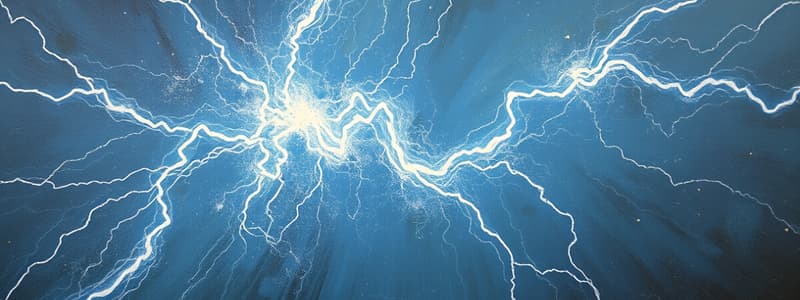Podcast
Questions and Answers
What is the charge of the electron given that it is rotating in a circular path?
What is the charge of the electron given that it is rotating in a circular path?
- 3.2 x $10^{-19}$ C
- 1.6 x $10^{-19}$ C (correct)
- 9.6 x $10^{-19}$ C
- 6.4 x $10^{-19}$ C
If the work done by the electron is 25 joules, what is the potential difference it experiences?
If the work done by the electron is 25 joules, what is the potential difference it experiences?
- 50 V
- 100 V
- 25 V (correct)
- 15.625 V
Given the frequency of rotation is 100 Hz, what is the angular frequency of the electron?
Given the frequency of rotation is 100 Hz, what is the angular frequency of the electron?
- 314.16 rad/s (correct)
- 628.32 rad/s
- 400 rad/s
- 200 rad/s
What is the centripetal force acting on the electron if it has a mass of $9.11 x 10^{-31}$ kg and is moving with a velocity of 8 m/s in a circular path?
What is the centripetal force acting on the electron if it has a mass of $9.11 x 10^{-31}$ kg and is moving with a velocity of 8 m/s in a circular path?
If the electron is moving at a velocity of 8 m/s in a circular path, what is the period of rotation?
If the electron is moving at a velocity of 8 m/s in a circular path, what is the period of rotation?
Study Notes
Electric Charge and Circular Motion
- An electron in circular motion can be described by its frequency, velocity, and the radius of its path.
- Given frequency: 100 Hz indicates the number of complete revolutions per second.
- Velocity of the electron: 8 m/s shows how fast the electron is moving along its circular path.
Calculating Quantity of Electric Charge
- The charge of an electron is approximately -1.6 x 10^-19 coulombs.
- The relationship between frequency (f), velocity (v), and radius (r) in circular motion is given by:
[ v = 2\pi f r ] - With the known frequency and velocity, the radius can be calculated if needed.
Work Done and Potential Difference
- Work done by the electron: 25 joules reflects the energy transfer as it moves in the electric field.
- The potential difference (V) can be calculated using the formula:
[ W = QV ]
Where W is work done, Q is charge, and V is potential difference. - To find the potential difference:
[ V = \frac{W}{Q} ]
Relating Work Done and Charge to Potential Difference
- To analyze the potential difference associated with the work done, rearranging the equation gives insights into how much charge is moved at a specific potential to do a certain amount of work.
- It highlights the connection between electric charge, energy, and voltage in a system.
Studying That Suits You
Use AI to generate personalized quizzes and flashcards to suit your learning preferences.
Description
This quiz delves into the concepts of electric charges, their motion, and the relationship with potential difference. Based on a scenario where an electron rotates in a circular path at 100Hz with a velocity of 8m/s, calculate the quantity of electric charge and relate this to a work done of 25 joules. Test your understanding of these electrical fundamentals!




